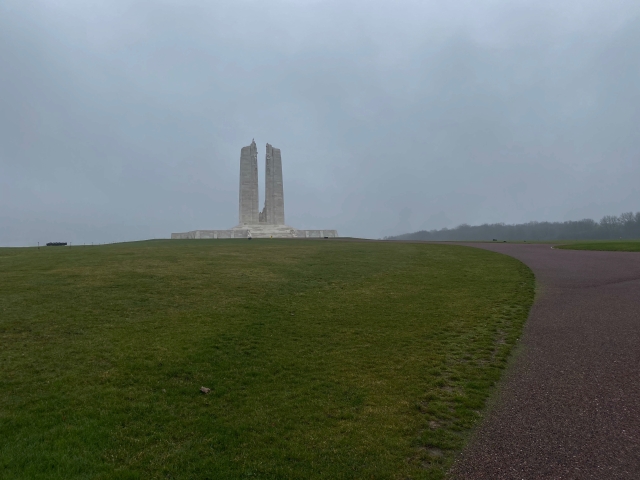
Continued from Part One.
From a distance it looks too stark to be a monument. The eye is, initially, disappointed as the form makes its modernistic impact. Both the height of the pylons and the width of the base ( a massive 6,000 tonnes of steel-reinforced concrete) look devoid of detail… but this is an illusion, for the Canadian National Monument on Vimy Ridge is designed to have many faces; some of them literal, others spoken of in bare symmetry.
The icy mist had continued to haunt us. Our last-minute dash to see Vimy before heading for Calais was a gamble. The damp and misty air made it almost impossible to hold the camera, making the fingers numb after only a few seconds of exposure.
But, if anything, the weather was perfectly aligned with the emotional goals of Canadian architect and sculptor Walter Seymour Allward (1876-1955), who, in 1921 won a competition set up by the Canadian government to create a national monument commemorating its soldiers killed in the First World War. His winning design became the Canadian National Vimy Memorial, established on the peak of Vimy Ridge – the site of one of WW1’s most horrific battles.
Walter Allward said the idea for the monument came to him in a dream:
“I turned my eyes and found myself looking down on an avenue of poplars… I have tried to show this in the monument to Canada’s fallen, what we owed them and will forever owe them.” Walter Allward
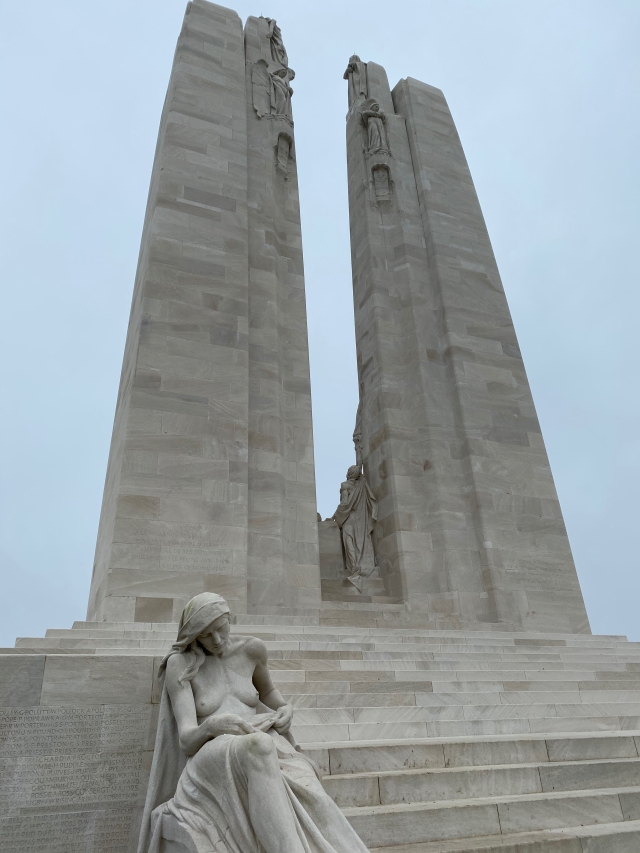
As you draw closer along the path that appears to be the entrance, two figures stand out from the base of the shining stone (6,000 tonnes of the purest limestone, quarried from a disused Roman mine in what is now Croatia). The first is a mother figure, naked from the waist up and looking down at her empty womb. The symbolism of her forlorn breasts stabs at the heart; it warns you that this monument is not for the faint-hearted, and marks the place where thousands of young Canadian soldiers died storming the ridge against the well-armed German army.
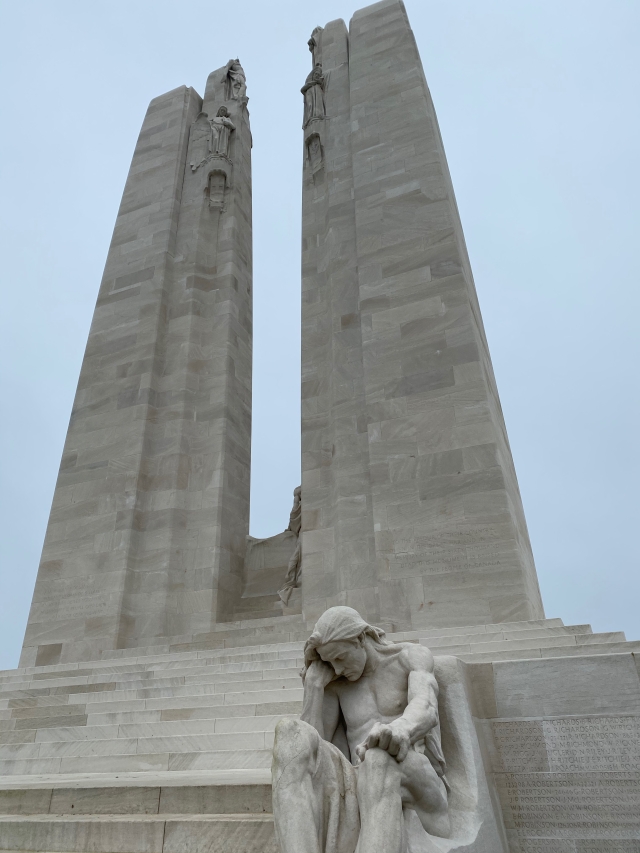
To the right along the base of the monument is the father figure, also half-naked and seated in anguish with his left hand clenched in anguish along the skin of his thigh; his right hand supporting the organ of thought and regret – his head.
The sheer poignancy of these two figures brings home the central story of the monument, which is one of time and events. We were not at the front of the sculptures but at the back. But there are no signs to say so… The visitor centre was closed for maintenance, so only exploration and understanding would bring that knowledge.
And, suddenly, you realise you are not only in story but a process of consciousness…
The two grieving figures represent the sorrow and mourning that comes after the deaths of the young men of their nation on an unprecedented scale. Though compelling, it is desperately sad… and immediately changes your consciousness. From here on across the monument, you are going backwards in time and events, in order to see what led to such loss.
Our eyes were beginning to grasp the design. There are figures high on the pylons at the front and in the rear of the central twin-structure. They represent Peace and Justice, Knowledge and Truth. We would only come to understand them in the context of what lay on the other side of the pylons…
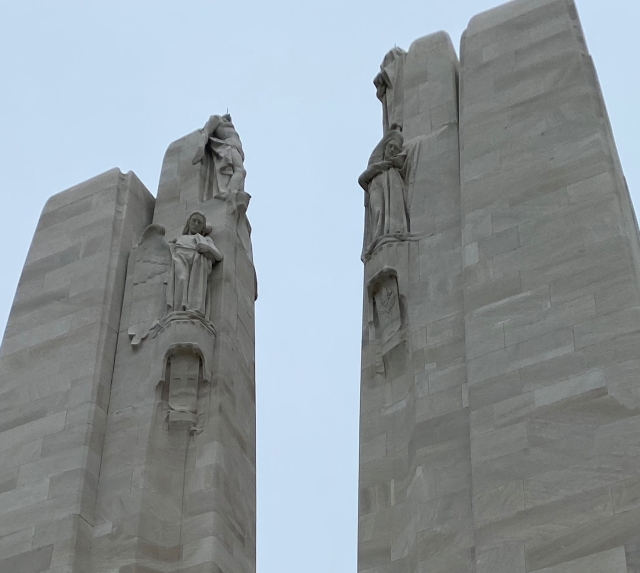
Beyond the vast base of the monument is the edge of Vimy Ridge; the downward slope is the site of most of the battle. A story was opening up before us, told in classical figures worked with beauty and precision in shining limestone – each one carved by Walter Allward in situ, even those at the top of the near-100ft pylons!
I looked up and wondered, given the state of my fingers here at ground level, how cold it was up there… That sense of having gone beyond and into the unknown must have been one of Allward’s main intentions. It’s beautiful and chilling at the same time; and speaks of the power of youth to go where it is guided – in this case into into the hell of war and isolation found at the top of those towers… the place of death in the wall of bullets from the German machine guns. But that is telling the story on the physical and not the moral level.
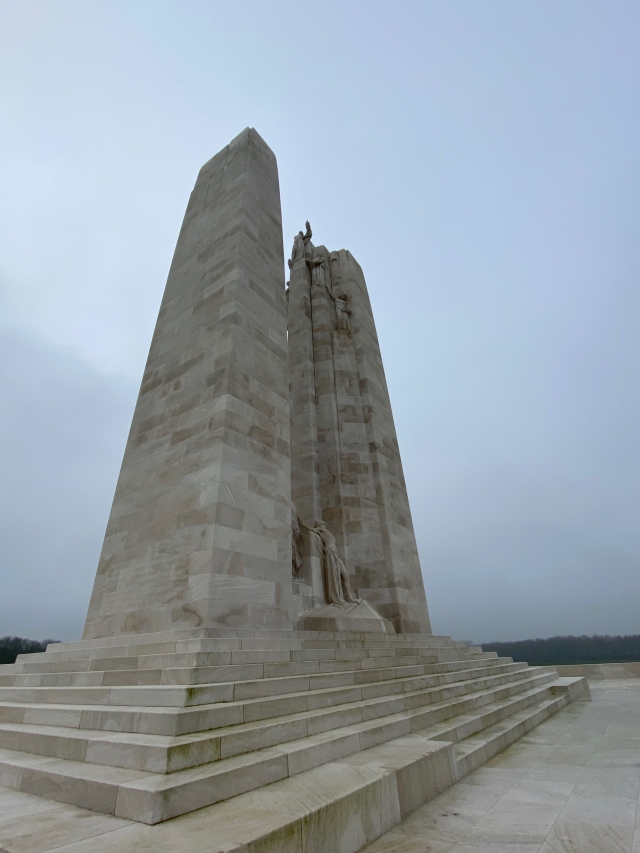
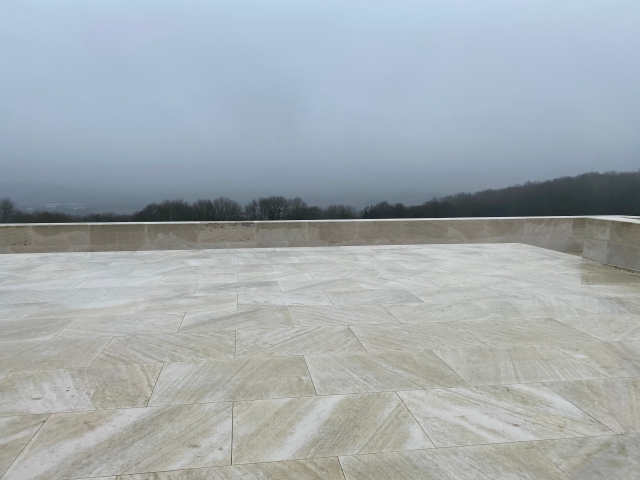
Inscribed on the far wall of the terrace is: ‘The Canadian Corps on 9th April 1917 with four divisions in line on a front of four miles attacked and captured this ridge’
Having understood the physical layout of the whole monument, we realised that we could not penetrate the symbolism further without descending to the lowest level and looking back from the perspective of the ridge being ‘attacked’ by the Canadian Army and defended by the German forces.
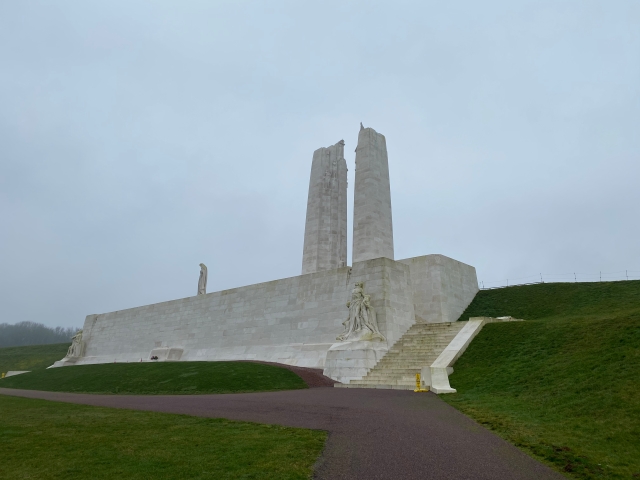
Knowing what was on the opposite face, we could now appreciate the whole of the monument. Visually, we were ‘advancing’ from below – just as the four divisions of Canadian soldiers did, as told in the words of the visitor plaque:
“After two unsuccessful Allied attempts to dislodge the Germans from this heavily fortified height, the four Canadian divisions, fighting together for the first time, seized the ridge on 12 April 1917 after four days of intense fighting. Meticulous preparation, the use of advanced technology, teamwork and the sacrifice of thousand of Canadian lives produced this remarkable result, It was an important turning point for Canada in the war.”
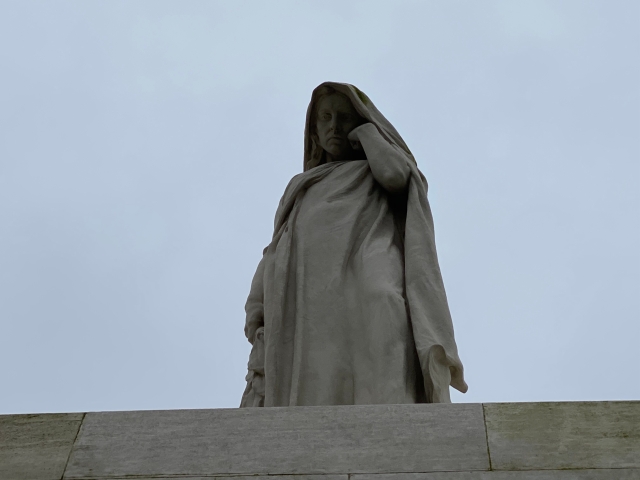
The single, central figure is revealed to be that of ‘Canada’. She gazes down Vimy Ridge, moved beyond words… but unmoving. Directly beneath her, at the base of the tall wall, is a tomb.
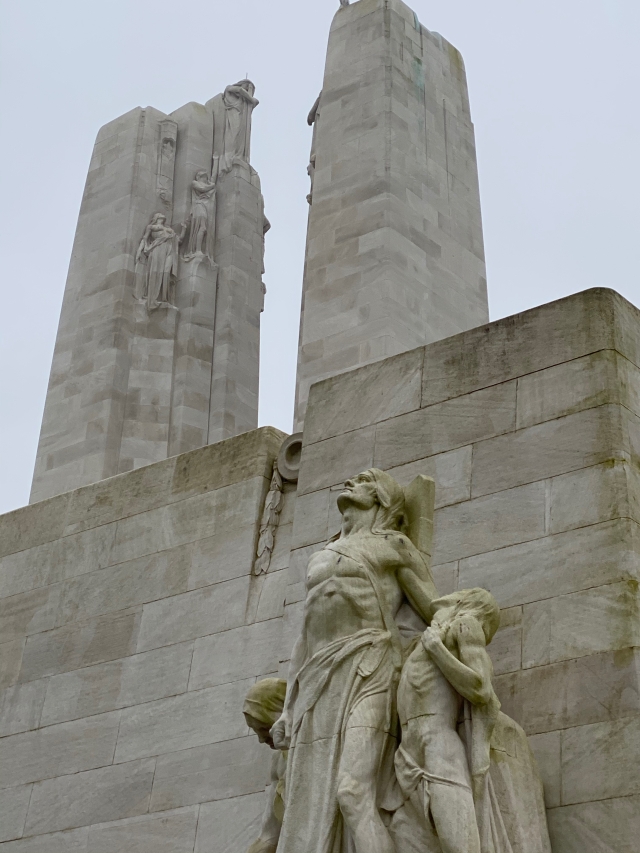
To the right of the downward-gazing figure of ‘Canada’ are the multiple figures of ‘Sympathy of Canadians for the Helpless’. It’s a beautifully carved sculpture and leads the eye to the twin pylons above – representing higher principles and forces at work in the human consciousness. This is an important point – the whole of the monument is about the human mind and heart, and their capacity for greatness or war – the ultimate failure of humanity’s communication and learning.
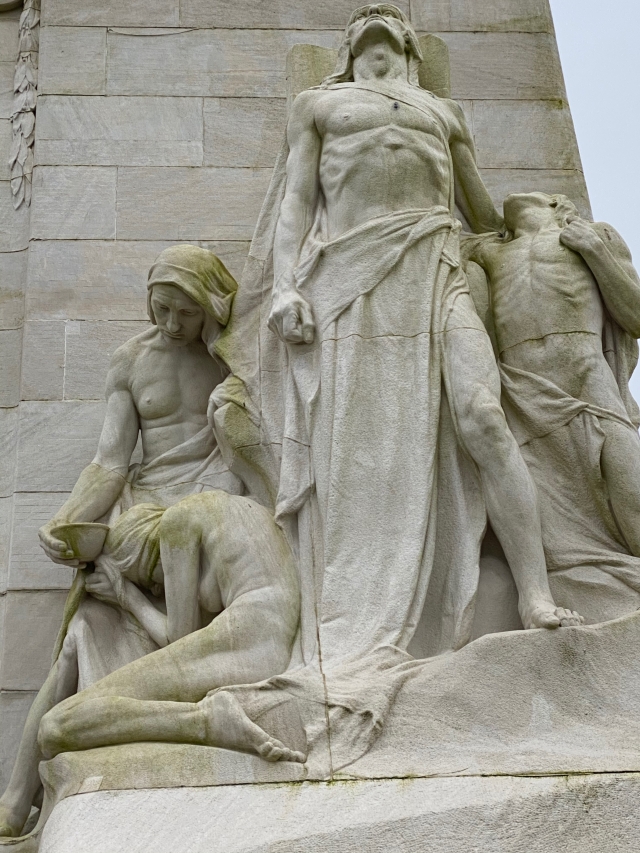
The basal wall is massive and runs the whole width of the monument. On the left of its face is an enigmatic piece known as “Breaking of the Sword’.
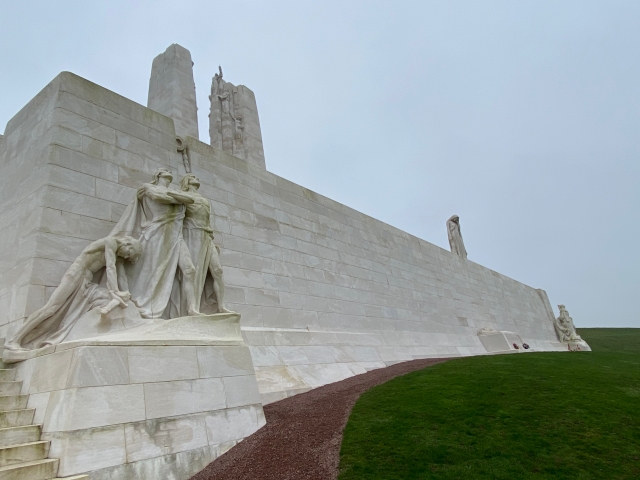
Beyond the guardian figure of ‘Canada’ the upper level can be gained by either set of stone steps. We returned to this and faced the complete set of figures on the twin pylons.
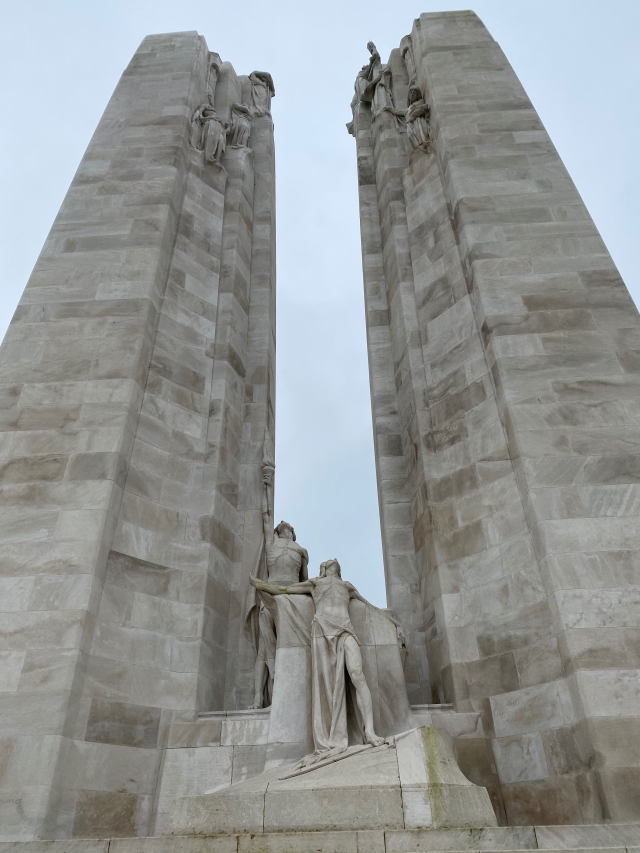
The middle two figures, between the bases of the pylons, are ‘Sacrifice’ and ‘The ‘Torch Bearer’. Both stare upwards into the heights of the cold sky… The demands of society and civilisation will carry a high price…
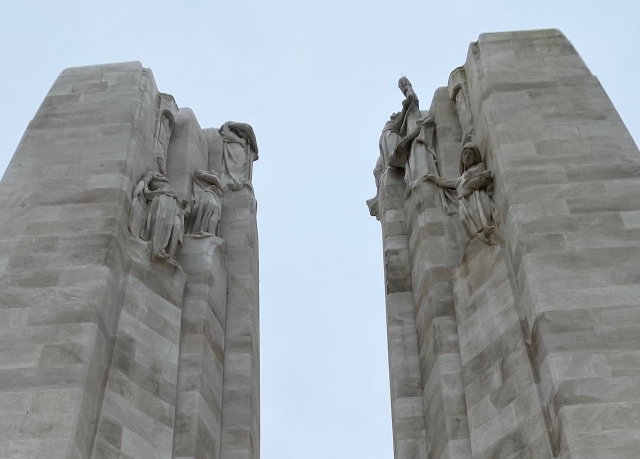
The figures here are curious. They are listed as (left) ‘Faith’ and ‘Hope’, but my eyes saw three ‘headless’ figures on the left (see photo) They may have been weather-damaged and in the process of restoration, but I definitely see three!. The figures on the top of the right pylon are listed as ‘Honour’ (top) and ‘Charity’.
Together, these are the focus of the figures of the Torch Bearer and Sacrifice – the very centre of the monument. These two are the ‘centre of the pillars’ – spiritually significant on any level. They tell the story of the whole of mankind, embarked on a near-impossible struggle between the inheritance of the animal nature–and its evolutionary ladder back to matter, and the inner flame of the divine; that which fights entropy by creating its own gradients.
The one quality I found to be unreferenced was ‘Will’. But then, I looked again and could see how Walter Allward had created the perfect tableau, one which took all his own willpower, but left the final ‘stone’ to the future observer. Only in our own hearts and minds will we find the inner will to gaze upwards, with the Torch Bearer and the Sacrifice our witnesses, and seek the peace that encompasses all differences.
I think Walter Allward, and, hopefully Canada, might echo that…
©Stephen Tanham
Stephen Tanham is a Director of the Silent Eye School of Consciousness, a not-for-profit teaching school of modern mysticism that helps people find a personal path to a deeper place within their internal and external lives.
The Silent Eye provides home-based, practical courses which are low-cost and personally supervised. The course materials and corresponding supervision are provided month by month without further commitment.
Steve’s personal blog, Sun in Gemini, is at stevetanham.wordpress.com.

So truly humbling 💜
That’s just the emotion, Willow x
Yes indeed 💜
It conveys the great loss so powerfully. Thanks for sharing your visit there with us, Steve.
Glad you were there, Eliza.
Reblogged this on Stuart France and commented:
Steve continues his exploration of One Nation State’s struggle against Empire…
Thanks, Stu.
Thanks for this, Steve. I knew about this monument, of course, but had never seen these details. It’s a fitting tribute to that terrible war.
Thank you, Audrey. It’s a very moving place, and the level of sculpture is astonishing.